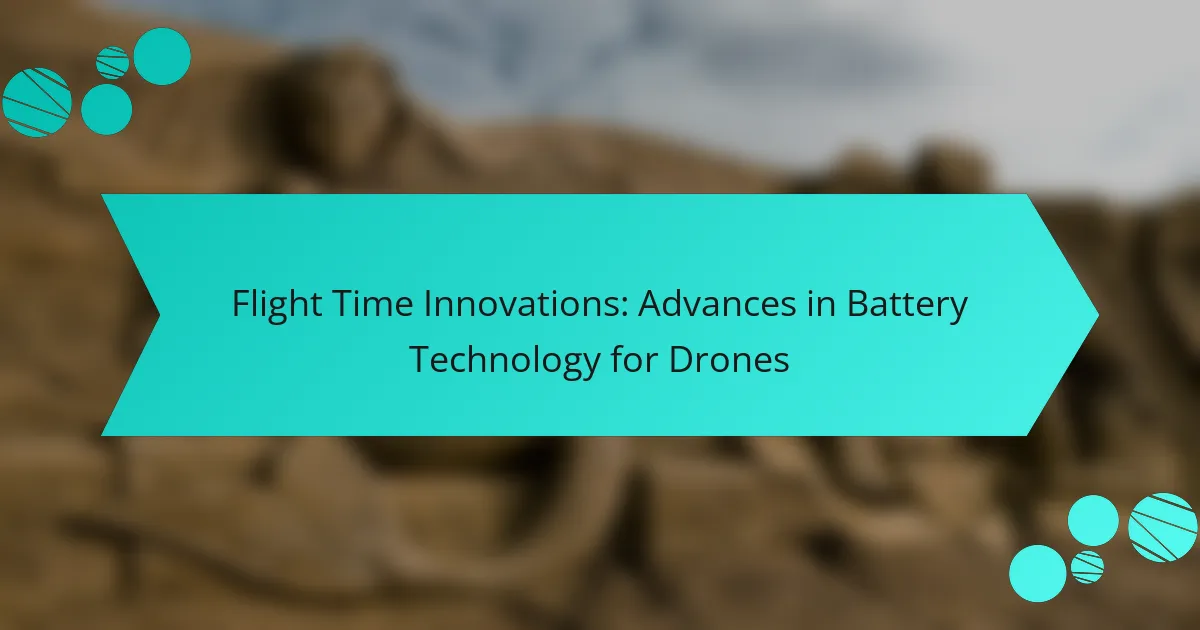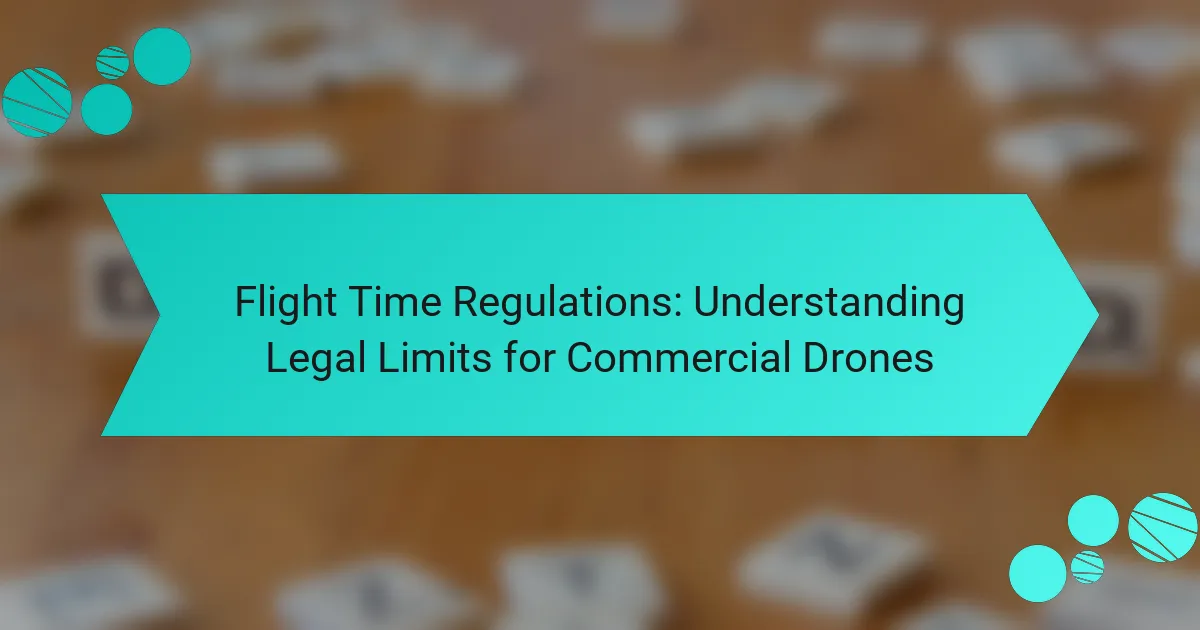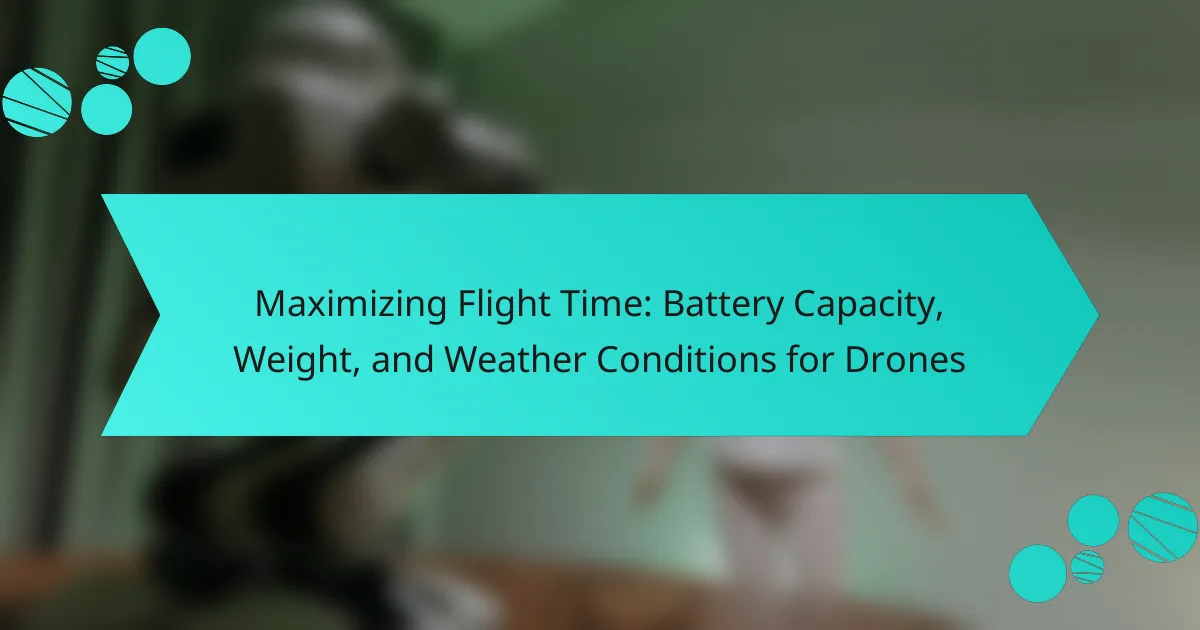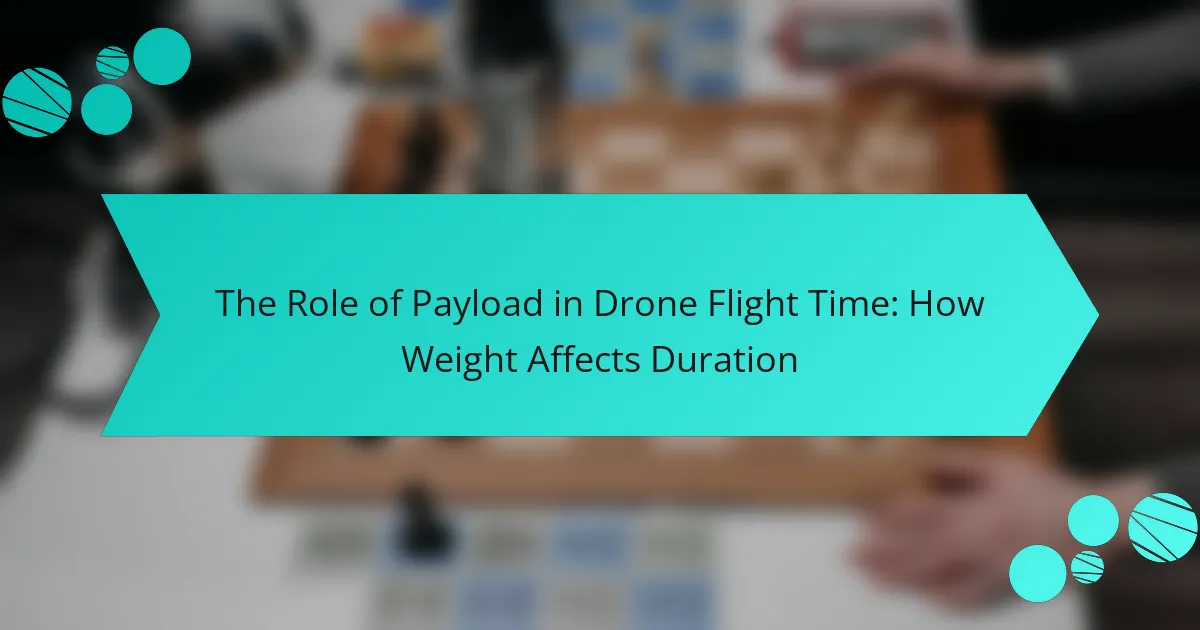
What factors influence drone flight time?
Drone flight time is influenced by several key factors. Battery capacity is the most significant factor. Higher capacity batteries, measured in milliamp hours (mAh), provide longer flight times. Weight of the drone also plays a crucial role. Heavier drones require more power to maintain flight, reducing overall time. Flight conditions, such as wind speed and temperature, affect performance. Strong winds can increase energy consumption, while extreme temperatures can impact battery efficiency. Flight style influences duration as well. Aggressive maneuvers consume more power compared to steady flight. Finally, the efficiency of the drone’s motors and propellers affects energy use. Efficient designs can extend flight time by optimizing power consumption.
How does battery capacity affect flight duration?
Battery capacity directly affects flight duration. Higher capacity batteries store more energy, allowing drones to fly longer. For instance, a 4500 mAh battery can provide more flight time than a 2200 mAh battery. This is because the drone can draw power from the larger battery for an extended period. Additionally, flight duration is influenced by the drone’s weight and energy consumption. A drone with a heavier load or higher energy demands will experience reduced flight time, even with a high-capacity battery. Therefore, choosing the right battery capacity is crucial for maximizing flight duration.
What is the relationship between mAh rating and flight time?
The mAh rating directly affects a drone’s flight time. A higher mAh rating indicates a larger battery capacity. This larger capacity allows the drone to draw power for a longer duration. Consequently, drones with higher mAh ratings can typically fly longer than those with lower ratings. For example, a drone with a 3000 mAh battery may achieve a flight time of around 20 minutes. In contrast, a 1500 mAh battery might only provide about 10 minutes of flight time. Therefore, increasing the mAh rating generally leads to extended flight times, enhancing overall performance.
How does battery condition impact performance?
Battery condition significantly impacts performance by affecting energy output and efficiency. A well-maintained battery delivers optimal voltage and capacity, which directly influences drone flight time. Conversely, a degraded battery may exhibit reduced capacity, leading to shorter operational periods. For instance, lithium-ion batteries lose capacity over time, often around 20% after 500 charge cycles. This degradation results in diminished performance, causing drones to experience reduced flight times and less stable operation. Additionally, poor battery condition can lead to voltage drops during usage, which can trigger safety mechanisms that reduce power output. Therefore, monitoring and maintaining battery health is crucial for maximizing drone performance.
What role does weight play in drone flight time?
Weight significantly impacts drone flight time. Heavier drones require more power to maintain lift. Increased power consumption leads to faster battery depletion. For instance, a drone weighing 1 kg may achieve 20 minutes of flight time. However, if the weight increases to 1.5 kg, flight time may reduce to 15 minutes. This relationship is due to the physics of lift and thrust. More weight necessitates greater thrust, which consumes additional energy. Therefore, minimizing weight can enhance overall flight duration.
How does payload affect battery consumption?
Payload increases battery consumption by requiring more power for lift and maneuverability. Heavier payloads demand additional energy from the battery to maintain flight stability. This results in a shorter flight duration. Research indicates that for every additional gram of payload, the energy consumption increases significantly. For instance, a study by the University of California found that a 10% increase in payload can lead to a 15-20% reduction in flight time. Thus, optimizing payload is crucial for maximizing battery efficiency in drones.
What are the implications of drone design on weight and flight time?
Drone design significantly impacts weight and flight time. A heavier drone requires more power to maintain flight. Increased weight can lead to shorter flight durations. Battery capacity must be sufficient to support the drone’s weight. Lighter materials can improve efficiency and extend flight time. For instance, using carbon fiber reduces weight without sacrificing strength. Additionally, aerodynamics play a role; a well-designed drone can glide more efficiently. Research indicates that every gram of weight affects battery life. Therefore, optimizing weight is crucial for maximizing flight time.
How do environmental conditions affect drone flight time?
Environmental conditions significantly affect drone flight time. Factors such as temperature, wind speed, and humidity play crucial roles. Higher temperatures can lead to increased battery efficiency, while lower temperatures often reduce battery performance. Wind speed impacts the drone’s energy consumption; strong winds require more power to maintain stability and control. Humidity can affect the weight of the drone due to water absorption in materials. Research shows that flying in adverse conditions can reduce flight time by up to 30%. Understanding these factors enables better planning for optimal drone operation.
What impact does temperature have on battery efficiency?
Temperature significantly impacts battery efficiency. High temperatures can lead to increased internal resistance in batteries. This results in reduced overall performance and shorter lifespan. Conversely, low temperatures can decrease the chemical reactions necessary for energy production. This reduces the battery’s capacity and efficiency. Studies show that lithium-ion batteries perform optimally between 20°C to 25°C. Outside this range, efficiency drops significantly, impacting devices like drones. For instance, performance can decrease by up to 20% at temperatures below 0°C. Thus, maintaining optimal temperature is crucial for maximizing battery life and performance in drones.
How do wind and weather conditions influence flight duration?
Wind and weather conditions significantly influence flight duration. Strong headwinds can increase flight time as drones must work harder to maintain speed. Conversely, tailwinds can decrease flight duration by aiding propulsion. Weather conditions like rain or snow can reduce battery efficiency, leading to shorter flight times. Temperature also affects battery performance; colder temperatures can decrease battery capacity. Studies show that adverse weather can reduce flight efficiency by up to 20%. Understanding these factors helps in planning optimal flight paths and durations.

What strategies can be employed to optimize drone battery life?
To optimize drone battery life, several strategies can be employed. First, minimizing weight is crucial. Lighter drones consume less energy during flight. Second, maintaining proper battery health extends lifespan. Regularly checking battery voltage and avoiding deep discharges are essential practices. Third, optimizing flight patterns can improve efficiency. Smooth, steady movements reduce energy consumption compared to aggressive maneuvers. Fourth, using energy-efficient propellers can enhance performance. High-quality propellers reduce drag, leading to longer flight times. Fifth, flying in optimal weather conditions is beneficial. Avoiding strong winds and rain can decrease battery strain. Lastly, regular firmware updates can improve energy management. Manufacturers often release updates that enhance battery performance and efficiency. These strategies collectively contribute to maximizing drone battery life.
How can flight planning enhance battery performance?
Flight planning can enhance battery performance by optimizing routes for efficiency. Efficient routes reduce unnecessary distance and time in the air. This minimizes energy consumption, leading to longer flight times. Additionally, planning can account for wind conditions, which impact battery drain. By avoiding strong headwinds, drones can conserve battery power. Furthermore, planned altitude adjustments can help maintain optimal energy use. Research indicates that strategic flight paths can improve battery life by up to 20%. This demonstrates the importance of thorough flight planning for maximizing drone battery efficiency.
What are the best practices for route optimization?
The best practices for route optimization involve planning efficient flight paths for drones. Start by analyzing the delivery area to identify the most direct routes. Utilize mapping software to visualize potential paths and avoid obstacles. Incorporate real-time data on weather and airspace restrictions to adjust routes dynamically. Prioritize shorter distances and minimize elevation changes to conserve battery life. Regularly review and update routes based on performance data and feedback. Implement waypoint navigation to streamline the flight process. These methods can enhance efficiency and extend flight time, ultimately improving overall performance.
How does altitude affect battery usage during flights?
Altitude affects battery usage during flights by influencing the air density and temperature. As altitude increases, air density decreases. This reduced density leads to less aerodynamic efficiency. Consequently, the drone’s motors must work harder to maintain lift. Increased motor strain results in higher energy consumption. Additionally, colder temperatures at higher altitudes can reduce battery efficiency. Lithium polymer batteries, commonly used in drones, can experience decreased performance in cold conditions. Therefore, flying at higher altitudes typically results in shorter flight times due to increased energy demands.
What maintenance practices can extend battery life?
Regular maintenance practices can significantly extend battery life. Keeping batteries clean prevents corrosion and ensures optimal performance. Properly storing batteries at a moderate temperature enhances longevity. Avoiding complete discharges helps maintain battery health. Charging batteries at the recommended rate prevents overheating and damage. Regularly checking for physical damage allows for timely replacements. Using compatible chargers ensures safe and efficient charging. Following manufacturer guidelines provides specific care instructions for different battery types.
How often should batteries be cycled for optimal performance?
Batteries should be cycled every 30 to 50 charge cycles for optimal performance. This cycling helps maintain the battery’s health and capacity. Regular cycling prevents issues like capacity loss and voltage drop. Proper cycling involves fully discharging and recharging the battery. This practice can extend the overall lifespan of the battery. Research indicates that lithium-ion batteries benefit from such maintenance. Following these guidelines ensures better performance over time.
What are the signs of battery wear and how can they be addressed?
Signs of battery wear include reduced capacity, swelling, and increased self-discharge rates. When a battery shows diminished capacity, it can hold less charge than when new. Swelling indicates internal damage and can lead to safety hazards. Increased self-discharge means the battery loses charge faster when not in use. To address these signs, users should monitor battery health regularly. Replacing old batteries is essential when wear is evident. Proper storage conditions can help prolong battery life. Avoid exposing batteries to extreme temperatures for optimal performance. Regularly cycling the battery can also maintain its health.
What modifications can be made to drones for better battery efficiency?
Modifications that can be made to drones for better battery efficiency include optimizing weight, improving aerodynamics, and upgrading battery technology. Reducing the overall weight of the drone decreases energy consumption. This can be achieved by using lightweight materials such as carbon fiber. Enhancing the drone’s aerodynamic design minimizes drag, allowing it to fly more efficiently. Streamlining the shape and reducing protrusions contribute to better airflow. Upgrading to high-capacity lithium polymer batteries increases energy storage and extends flight time. Implementing energy-efficient motors and propellers also enhances performance. These modifications collectively improve battery efficiency and overall flight duration.
How can software updates improve battery management?
Software updates can improve battery management by optimizing power consumption and enhancing charging algorithms. These updates often include bug fixes that reduce unnecessary battery drain. They may also introduce new features that adjust settings based on usage patterns. For example, updates can enable adaptive brightness or background app management. Enhanced charging algorithms can extend battery lifespan by preventing overcharging. According to a study by Battery University, optimized software can increase battery efficiency by up to 20%. Regular updates ensure that devices operate at peak performance, thereby improving overall battery management.
What hardware upgrades can enhance battery life?
Upgrading to a higher-capacity battery can significantly enhance battery life. Larger batteries store more energy, allowing for longer flight times. Switching to lightweight materials for the drone’s frame reduces overall weight. A lighter drone requires less power to maintain flight. Upgrading to more efficient motors can also improve battery life. Efficient motors convert electrical energy into mechanical energy more effectively. Additionally, using advanced electronic speed controllers (ESCs) can optimize power usage. ESCs with better algorithms manage energy distribution more effectively. Finally, incorporating energy-efficient propellers reduces drag and improves overall efficiency. Enhanced efficiency translates to extended flight duration.
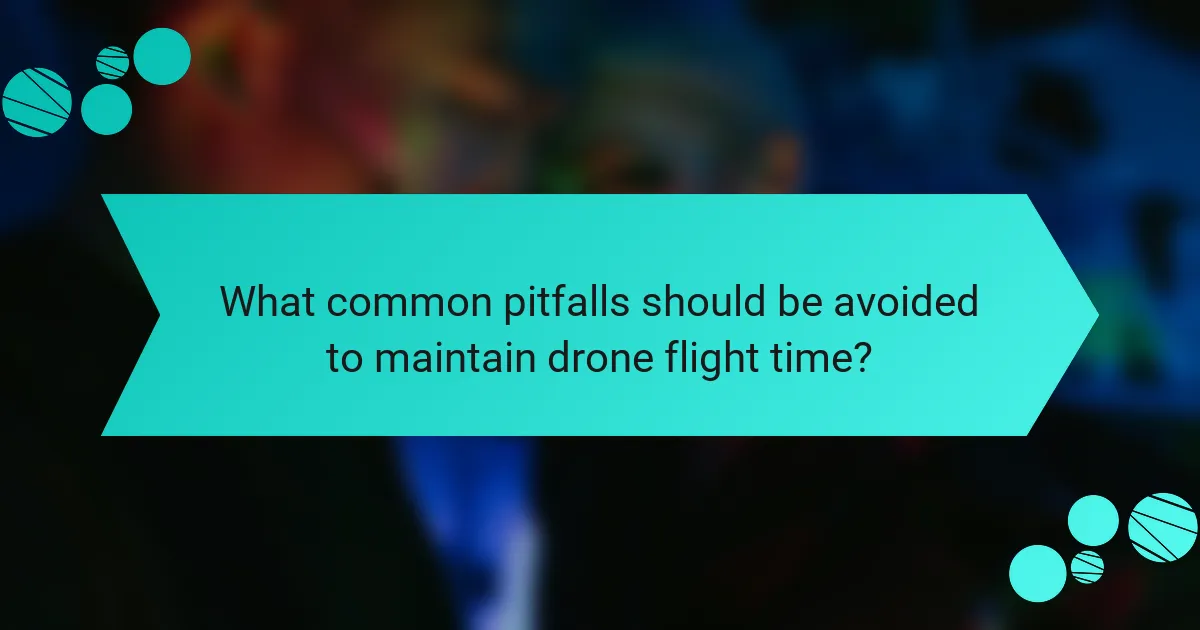
What common pitfalls should be avoided to maintain drone flight time?
Avoiding common pitfalls is essential for maintaining drone flight time. One major pitfall is flying in extreme temperatures. Cold weather can reduce battery efficiency. Similarly, high temperatures can lead to overheating and damage. Another issue is ignoring battery maintenance. Regularly checking battery health can prevent unexpected failures. Overloading the drone with extra weight can also shorten flight time. Each additional gram affects battery drain. Additionally, failing to calibrate the drone before flights can lead to inefficient energy use. Lastly, not planning flight paths can cause unnecessary energy expenditure. Efficient routes maximize battery life and extend flight duration.
What mistakes do drone operators make regarding battery usage?
Drone operators often make several mistakes regarding battery usage. One common mistake is failing to fully charge the battery before flight. Batteries should be charged to their maximum capacity for optimal performance. Another mistake is not monitoring battery health regularly. Regular checks can prevent unexpected failures during flight. Additionally, operators may ignore temperature effects on battery performance. Extreme temperatures can significantly reduce battery efficiency. Over-discharging the battery is also a frequent error. This can lead to permanent damage and reduced lifespan. Lastly, operators sometimes use non-compatible chargers. Using the correct charger ensures safe and effective charging.
How can improper charging practices affect battery longevity?
Improper charging practices can significantly reduce battery longevity. Overcharging can lead to excessive heat, which damages battery cells. Heat accelerates chemical reactions inside the battery, resulting in faster degradation. Undercharging can also harm batteries by not fully utilizing their capacity. Frequent deep discharges can diminish overall battery life. Lithium-ion batteries, commonly used in drones, typically last longer with partial discharges. According to Battery University, maintaining a charge between 20% and 80% optimizes lifespan. Following proper charging guidelines is essential for maximizing battery performance.
What are the consequences of overloading a drone?
Overloading a drone can lead to several serious consequences. It can reduce flight stability and control. This instability increases the risk of crashes. Overloading also strains the drone’s motors and battery. Consequently, this can lead to overheating and potential failure. The drone may experience shorter flight times due to increased weight. Additionally, it can cause excessive wear on components, reducing the drone’s lifespan. Regulatory compliance may also be compromised, leading to legal issues.
What troubleshooting steps can be taken to resolve battery issues?
Check the battery connections for any loose or corroded terminals. Ensure that the battery is properly seated in the drone. Inspect the battery for physical damage, such as swelling or cracks. Confirm that the battery is charged using the correct charger. Test the battery with a multimeter to check its voltage. Replace the battery if it does not hold a charge or shows abnormal readings. Update the drone’s firmware to ensure compatibility with the battery. Monitor the battery’s temperature during use to prevent overheating.
How can users diagnose reduced flight time problems?
Users can diagnose reduced flight time problems by checking battery health and charge levels. Inspect the battery for any signs of damage or swelling. Measure the voltage of the battery using a multimeter. Compare the voltage to the manufacturer’s specifications. Review the drone’s weight and payload; excessive weight can reduce flight time. Examine the propellers for damage or misalignment, as these can affect efficiency. Monitor flight conditions such as temperature and wind, which can impact performance. Finally, update the drone’s firmware, as software issues can also lead to reduced flight time.
What are the most effective solutions for common battery problems?
To address common battery problems effectively, ensure proper charging practices. Use compatible chargers to prevent damage. Regularly clean battery contacts to maintain optimal performance. Monitor temperature during use; excessive heat can reduce lifespan. Store batteries in a cool, dry place when not in use. Avoid deep discharges to extend battery life. Consider using battery management systems for monitoring. Replace old or damaged batteries promptly to ensure reliability.
What are the best practices for ensuring optimal drone performance?
To ensure optimal drone performance, regularly maintain and calibrate the drone. This includes checking propeller condition and battery health. Keeping firmware updated enhances functionality and performance. Flying in optimal weather conditions prevents unnecessary strain on the drone. Using the correct payload weight maximizes efficiency and flight time. Adhering to recommended flight patterns improves battery usage. Monitoring battery levels during flight ensures timely landings. Following these practices can significantly enhance drone performance and longevity.
The main entity of the article is drone flight time, which is critically influenced by various factors such as battery capacity, weight, environmental conditions, and flight style. The article provides an in-depth analysis of how these attributes affect battery performance and overall flight duration, emphasizing the importance of optimizing battery life through strategies like weight management, efficient flight planning, and regular maintenance. Key sections include the relationship between battery capacity (measured in mAh) and flight time, the impact of payload and design on energy consumption, and practical tips for enhancing battery efficiency and drone performance. Additionally, common pitfalls and troubleshooting steps are outlined to help users maximize their drone’s operational capabilities.
